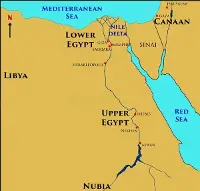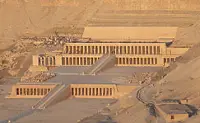Thebes: Royal Heart of Egypt
Thebes was an important city for most of the life of Ancient Egypt, for a long time serving as the royal capital. 
Thebes was about 500 miles south of the Mediterranean Sea and about 450 miles south of Cairo. The Nile River split the 36 square miles of the city of Thebes in two: On the east bank was the main city, and on the west bank was the necropolis, wherein could be found the Valley of the Kings and the Valley of the Queens. It was known to the people who lived there as Waset, or "City of the Was." A "was," the staff of the pharaohs, was a long fork-based staff atop which sat the head of an animal. The name Thebes came from the Greek Thebai. The first inhabitants of the city settled about 3200 B.C. In earlier days, in what was known as the Old Kingdom, Thebes was a minor trading post and the capital was Memphis, then Herakleopolis. Historians generally credit the pharaoh Mentuhotep II, who ruled in the 20th Century B.C. as establishing Thebes as a thriving royal capital. It started out small, grew steadily, and at its height had a population of 80,000. 
Thebes played a leading role in maintaining the sovereignty of Upper Egypt during the century-long reign of the Hyksos in the north. Thebes and the Hyksos kings maintained grudgingly peaceful relations, and Theban kings allowed Hyksos trade vessels to sail right past, on their way to and from the land of the Nubians. On the other side of the coin, it was the Theban kings Kamose and then Ahmose I who organized the military overthrow of the Hyksos. Thebes then regained its status as capital of all Egypt. Akhenaten, in the 13th Century B.C. moved the center of his government to Amarna. His son Tutankhamen declared Thebes the capital city again, and it remained so for several more centuries. Ramses II, during his reign, declared the capital to be a city he created, Pi-Ramses. Armies of the Assyrian Empire sacked Thebes in 663 B.C. The city recovered for a time but fell victim completely to Roman armies in the 1st Century A.D. Amun was the supreme god of Thebes. Numerous temples in the city, among the famous sprawling complex of Kanrak, were dedicated to him. The two other main gods of the city were Khonsu and Mut. The later Luxor Temple played to host to the Opet Festival, one of the religious calendar's most sacred events. Several dozen religious festivals occurred regularly in the city as well. At one time, a two-mile-long avenue flanked by sphinxes linked the Luxor Temple and Karnak. Thebes was also home to temples associated with individual pharaohs, among them:
|
|
Social Studies for Kids
copyright 2002–2024
David White



 the famous female pharaoh
the famous female pharaoh 
